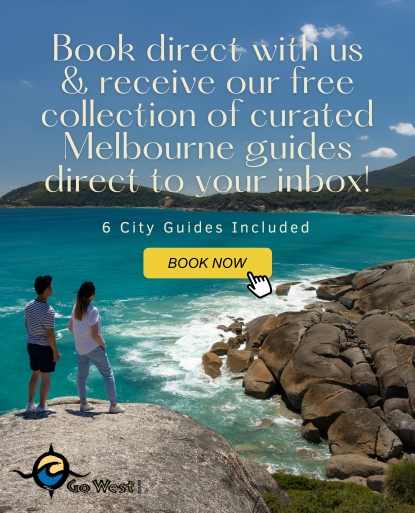Take a tour to Phillip Island to discover The Nobbies and Seal Rocks, as well as the famous Little Penguin colony.
Just under 2 hours drive from Melbourne is Phillip Island. It is famous for the colony of Little Penguins that make their homes on the island. Each night thousands of these penguins return from feeding in the ocean and waddle across the beach to their burrows in the sand dunes. The Penguin Parade is the best place to watch this phenomenon up close, without disturbing the penguins or their natural environment.
But the Penguin Parade is not the only attraction on Phillip Island. The island is a haven for many types of wildlife, marine life and bird life. Parts of the island are protective to allow the native flora and fauna to thrive.
On our Phillip Island day tour from Melbourne we visit Point Grant to discover the Nobbies and Seal Rocks. It’s a great opportunity to look for Little Penguins in their burrows, view the incredible scenery and look for other wildlife including the island’s fur seal colony.
What are The Nobbies and Seal Rocks?
The Nobbies are dome-shaped rock formations off the coast of Phillip Island which provide an important home to the island’s Little Penguins. They can be viewed from the boardwalks at Point Grant and the Nobbies Visitor Centre. Viewing the Nobbies before sunset gives you fantastic views out to the Southern Ocean and across Western Port Bay.
Seal Rocks are flatter rocks further off the coast of Phillip Island. They are a home to Melbourne’s largest colony of Australian fur seals. They feed in the waters surrounding Phillip Island and can be found resting and sleeping on the rocks. At Point Grant there are binoculars along the boardwalk which can be used to spot the marine creatures out on Seal Rocks.
What other attractions are at Point Grant?
Little Penguins
A stroll around the boardwalk is not all about the views – there is also a chance to see the Little Penguins in their nests. The penguins nest in burrows, but rangers from Phillip Island Nature Parks, have also built little wooden boxes to mimic the burrows. This provides a warm, dry place for the penguins to nest.
The penguins stay in their burrows and out of sight of potential predators during daylight hours, so the best viewing opportunities are to look into the entrance of the wooden boxes, or you might get lucky and spot a penguin hiding underneath the boardwalk.
Sea Birds
There are plenty of other sea birds that you can spot around the Nobbies and Seal Rocks. Look out for the large grey Cape Barron geese. They are generally in pairs and have chicks with them in spring time. Large gulls and whte-bellied sea eagles can be seen circling above the water’s edge looking for food below.
Between September and April you might spot large flocks of short-tailed shearwaters (mutton birds) returning to the island at sunset. These migratory birds make an 8,000 kilometres journey from the Alaskan Aleutian Islands to Phillip Island each year.
The Nobbies Blowhole
If you follow the boardwalks at Point grant they will take you the Nobbies Blowhole. A hollowed-out section of the cliffs where waves crash in and mist sprays back out. Is there is a large southerly swell, the blowhole will be at its most spectacular and is well worth a look.
Whale watching
Around June/July and again in October/November, you can witness whales passing by the coast of Phillip Island. At times they have even been spotted frolicking and searching for food in Western Port Bay. Southern Right whales are the most common, but Humpback whales and even Orcas have been spotted there as well.
These whales make a journey north from Antarctica each year to breed and give birth to their young in warmer waters. They then return to the icy waters down south. There are a few breeding areas or ‘nurseries’ along Victoria’s coastline. But in particular the sea life around Phillip Island seem to attract the whales to that area.
What else will you do on our Phillip Island Day Tour?
The Nobbies and Seal Rocks is not the only stop on our Phillip Island tour – here’s what else is included:
- Visit the famous Brighton Beach boxes
- Take a guided tour of the award-winning Moonlit Sanctuary Wildlife Conservation Park
- Meet and feed a wide range of Australian animals including koalas, wombats, dingoes, and more
- Visit the Penguin Parade to witness thousands of Little Penguins returning from the ocean to their burrows in the dunes
Frequently Asked Questions
Where are The Nobbies and Seal Rocks?
The Nobbies and Seal rocks are located on Phillip Island – just under 2 hours drive south-east from Melbourne. Access to the island is via a bridge from the small town of San Remo.
Which penguins live on Phillip Island?
Phillip Island is home to the world’s largest colony of Little Penguins. This species of penguin is blue and white in colour, and makes its home in a burrow in the sand dunes. They spend time at sea to hunt for fish and return to the island after sunset.
Written by: Leah Furey – Digital Content Coordinator @gowest.com.au


